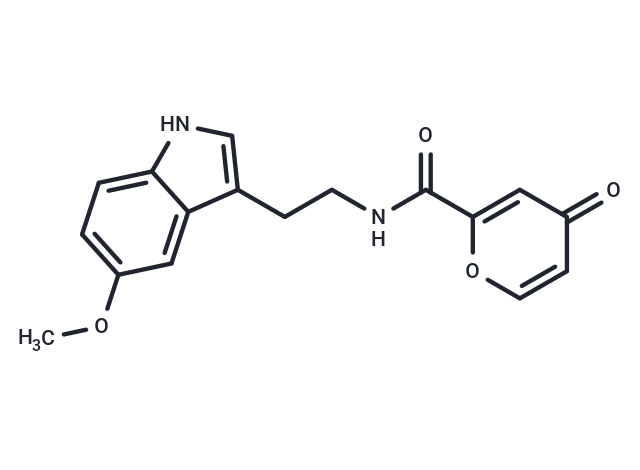Shopping Cart
- Remove All
 Your shopping cart is currently empty
Your shopping cart is currently empty

Piromelatine is an agonist of melatonin MT1/MT2 receptors, 5-HT1A and 5-HT1D, and an antagonist of 5-HT2B.Piromelatine has antinociceptive activity with inhibitory effects on P2X3, TRPV1, and Nav1.7 channels, and can be used in studies of sleep-promoting, pain-relieving, anti-neurodegenerative, and antidepressant diseases. diseases, and can be used to improve memory deficits associated with chronic mild stress-induced lack of pleasure in rats.

| Pack Size | Price | Availability | Quantity |
|---|---|---|---|
| 1 mg | $58 | In Stock | |
| 5 mg | $139 | In Stock | |
| 10 mg | $198 | In Stock | |
| 25 mg | $372 | In Stock | |
| 50 mg | $579 | In Stock | |
| 100 mg | $793 | In Stock | |
| 1 mL x 10 mM (in DMSO) | $153 | In Stock |
| Description | Piromelatine is an agonist of melatonin MT1/MT2 receptors, 5-HT1A and 5-HT1D, and an antagonist of 5-HT2B.Piromelatine has antinociceptive activity with inhibitory effects on P2X3, TRPV1, and Nav1.7 channels, and can be used in studies of sleep-promoting, pain-relieving, anti-neurodegenerative, and antidepressant diseases. diseases, and can be used to improve memory deficits associated with chronic mild stress-induced lack of pleasure in rats. |
| In vivo | Piromelatine (Neu-P11) has been shown to inhibit weight gain and improve insulin sensitivity in high-fat/high-sucrose-fed (HFSD) rats. The objective of this study was to investigate the effects of piromelatine on insulin sensitivity in sleep-restricted rats. Sleep restriction was established by rotating cages intermittently for 20h thereby sleeping time of rats was limited to 4 hours per day. During 8 days of sleep restriction, rats were injected intraperitoneally with piromelatine (20mg/kg), melatonin (5mg/kg), or a vehicle. The results showed that sleep restriction increased plasma glucose, fasting insulin, total cholesterol (TC), triglycerides (TG), and oxidative stress markers while HDL-cholesterol (HDL-C) level and glucose tolerance were decreased. However, under piromelatine or melatonin treatment, the levels of plasma glucose, TG, and TC decreased and HDL-C, glucose tolerance, and antioxidative potency increased when compared with the vehicle-treated group. Piromelatine could regulate metabolic profiles and insulin sensitivity, and attenuate insulin resistance induced by sleep restriction.[3] |
| Alias | NEU-P-11, NEU-P11, NEU-P 11 |
| Molecular Weight | 312.32 |
| Formula | C17H16N2O4 |
| Cas No. | 946846-83-9 |
| Smiles | COc1ccc2[nH]cc(CCNC(=O)c3cc(=O)cco3)c2c1 |
| Relative Density. | no data available |
| Storage | Powder: -20°C for 3 years | In solvent: -80°C for 1 year | Shipping with blue ice. | |||||||||||||||||||||||||||||||||||
| Solubility Information | DMSO: 100 mg/mL (320.18 mM), Sonication is recommended. | |||||||||||||||||||||||||||||||||||
Solution Preparation Table | ||||||||||||||||||||||||||||||||||||
DMSO
| ||||||||||||||||||||||||||||||||||||

Copyright © 2015-2025 TargetMol Chemicals Inc. All Rights Reserved.